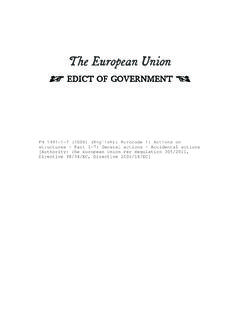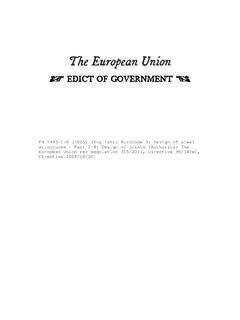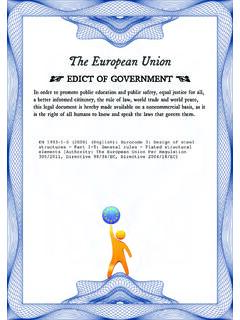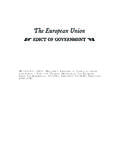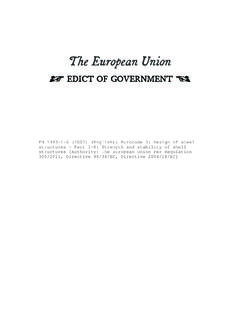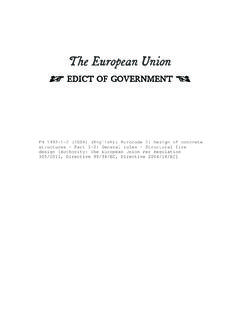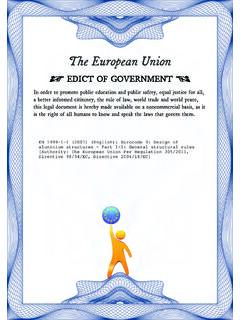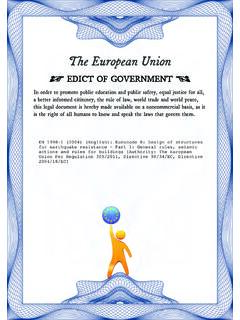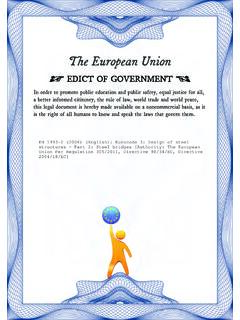Transcription of EN 1993-1-1: Eurocode 3: Design of steel structures - Part ...
1 The European UnionIn order to promote public education and public safety, equal justice for all, a better informed citizenry, the rule of law, world trade and world peace, this legal document is hereby made available on a noncommercial basis, as it is the right of all humans to know and speak the laws that govern them. EDICT OF GOVERNMENT EN 1993-1-1 (2005) (English): Eurocode 3: Design of steelstructures - Part 1-1: General rules and rules for buildings[Authority: The European Union Per Regulation 305/2011,Directive 98/34/EC, Directive 2004/18/EC]EUROPEAN STANDARD EN 1993-1-1 NORME EUROPEENNE EUROpAISCHE NORM ICS ; May 2005 English version Supersedes ENV 1993-1-1: 1992 Incorporating Corrigenda February 2006 and March 2009 Eurocode 3: Design of steel structures -Part 1-1: General rules and rules for buildings Eurocode 3: Calcul des structures en aeier - Partie 1-1: Regles gE'merales et regles pour les batiments Eurocode 3: Bemessung und Konstruktion von Stahlbauten - TeiI1-1: Allgemeine Bemessungsregeln und Regeln fOr den Hochbau This European Standard was approved by CEN on 16 April 2004.
2 CEN members are bound to comply with the CEN/CENELEC Internal Regulations which stipulate the conditions for giving this European Standard the status of a national standard without any alteration. Up-to-date lists and bibliographical references concerning such national standards may be obtained on application to the Central Secretariat or to any CEN member. This European Standard exists in three official versions (English, French, German). A version in any other language made by translation under the responsibility of a CEN member into its own language and notified to the Central Secretariat has the same status as the official versions. CEN members are the national standards bodies of Austria, Belgium, Cyprus, Czech Republic, Denmark, Estonia, Finland, France, Germany, Greece, Hungary, Iceland, Ireland, Italy, Latvia, Lithuania, Luxembourg, Malta, Netherlands, Norway, Poland, Portugal, Slovakia, Slovenia, Spain, Sweden, Switzerland and United Kingdom.
3 ECROPEA)'! COMMITTEE FOR STANDARDIZATION COM CROPEEN D NORMALISATION EUROPAISCHES KOMIT E FeR '-.'ORMUNCi Management Centre: rue de Stassart, 36 B-1050 Brussels 2005 CEN All rights of exploitation in any form and by any means reserved worldwide for CEN national Members. Ref. No. EN 1993-1-1 :2005: E BS EN 1993-1-1: 2005 EN 1993-1-1: 2005 (E) Contents Page Ceneral .. 9 Scope .. 9 .. 10 ASSlll1'1 IJlions .. 11 Distinction bet}veen principles and application rules .. 11 Terl1'7S and .. 11 ~vlnbols .. 12 Conventions/or member axes .. 20 2 Basis of Design .. 22 Requirelnents .. 22 2.] .1 Basic requirenlents .. 22 Reliability management .. 22 Design working life, durability and robustness .. 22 Principles qf'limit state.
4 23 Basic variables .. 23 Actions and environmental influences .. 23 Material and product prope11ies .. 23 Verification the partialfactor lnethod .. 23 Design values of material properties .. 23 Design values of geometrical data .. 23 Design resistances .. 24 Verification of static equilibrium (EQU) .. 24 Design a.,'sisled testing .. 24 3 Materials .. 25 General .. 25 Structur(}! sleel .. 25 Material properties .. 25 Ductility requirelnents .. 25 Fracture .. 25 Through-thickness properties .. 27 Tolerances .. 28 Design values of material coefficients .. 28 Connecting clevices .. 28 Fasteners .. 28 Welding cOl1sun1ablcs .. 28 Other prefabricated products in buildings .. 28 4 Durability.)
5 28 5 Structural analysis .. 29 Structural modellingfor analysis .. 29 Structural modelling and basic assumptiol1s .. 29 2 BS EN 1993-1-1: 2005 EN 1993-1-1: 2005 (E) Joint 1110delling .. 29 Ground- structure interaction .. 29 Global .. 30 Effects of deformed geometry of tbe structure .. 30 Structural stability of frames .. 31 Inlper(ection,I,' .. 32 Basis .. 32 Imperfections for global analysis of frames .. 33 Imperfection for analysis of bracing systems .. 36 Mel11ber inlperfections .. l'vfelhods of ana(vsis considering material non-/inearities .. 38 General .. 38 Elastic global analysis .. 39 Plastic global analysis .. 39 Classffication of cross sections .. 40 Basis .. 40 Classification .. 40 Cros.))
6 ",'-,)'ection requirements for plastic global analysis .. 41 6 IJltilnate linlit states .. 45 General .. 45 Re.)'istance cross-sections .. 45 General .. 45 Sectioll properties .. 46 Tension .. 49 .. 49 Bending nlonlent .. 50 Shear .. 50 7 Torsion .. 52 Bending and shear .. 53 Bending and axial force .. 54 Bending, shear and axial force .. 56 Buckling resistance ,l71el71bers .. 56 Uniform members in compression .. 56 Uniform members in bending .. 60 Uniform members in bending and axial compression .. 64 General method for lateral and lateral torsional buckling of structural components .. 65 Lateral torsional buckling of membcrs with plastic hinges .. 67 Untform built-lip compression members.
7 69 General .. 69 Laced compression members .. 71 Battened compression members .. 72 Closely spaced built-up members .. 74 7 Serviceability limit states .. 75 General .. 75 Serviceabili(v limit statesfoJ' buildings .. 75 deflections .. 75 Horizontal deflections .. 75 Dynanlic effects .. 75 Annex A [informative] -l\lethod 1: Interaction factors kij for interaction formula in (4) .. 76 3 BS EN 1993-1-1: 2005 EN 1993-1-1: 2005 (E) Annex B [informative] - Method 2: Interaction factors kiJ for interaction formula in (4) .. 79 Annex AB [informative] - Additional Design provisions .. 81 Annex BB [informative] - Buckling of components of building structures .. 82 4 Foreword BS EN 1993-1-1: 2005 EN 1993-1-1: 2005 (E) This European Standard EN 1993, Eurocode 3: Design of steel structures , has been prepared by Technical Committee CEN/TC250 Structural Eurocodes , the Secretariat of which is held by BSI.)
8 CEN/TC250 is responsible for all Structural Eurocodes. This European Standard shall be given the status of a National Standard, either by publication of an identical text or by endorsement, at the latest by November 2005, and conflicting National Standards shall be withdrawn at latest by March 2010. This Eurocode supersedes ENV 1993-1-1. According to the CEN-CENELEC Internal Regulations, the National Standard Organizations of the following countries are bound to implement these European Standard: Austria, Belgium, Cyprus, Czech Republic, Denmark, Estonia, Finland, France, Germany, Greece, Hungary, Iceland, Ircland, Italy, Latvia, Lithuania, Luxembourg, Malta, Netherlands, Norway, Poland, Portugal, Slovakia, Slovenia, Spain, Swedcn, Switzerland and United Kingdom.
9 Background of the Eurocode programme In 1975, the Commission of the European Community decided on an action programme 111 the field of construction, based on article 95 of the Treaty. The objective of the programme was the elimination of technical obstacles to trade and the harmonization of technical speci1~cations. Within this action programme, the Commission took the initiative to establish a set of harmonized technical rules for the Design of construction works which, in a first stage, would serve as an alternativc to the national rules in force in the Member States and, ultimately, would replace them. For fifteen years, the Commission, with the help of a Stcering Committee with Representatives of Member States, conducted the development of the Eurocodes programme, which led to the first generation of European codes in the 1980s.
10 In 1989, the Commission and the Member States of the EU and EFTA decided, on the basis of an agreement I between the Commission and CEN, to transfer the preparation and the publication of the Eurocodes to the CEN through a series of Mandates, in order to provide them with a future status of European Standard (EN). This links de facto the Eurocodes with the provisions of all the Council's Directives and/or Commission's Decisions dealing with European standards ( the Council Directive 89/1 06/EEC on construction products ~ CPD ~ and Council Directives 93/37/EEC, 92/50/EEC and 89/440/EEC on public works and services and equivalent EFTA Directives initiated in pursuit of setting up the internal market). The Stluctural Eurocode programme comprises the following standards generally consisting of a number of Parts: EN 1990 Eurocode : Basis of structural Design EN 1991 Eurocode 1: Actions on structures EN 1992 Eurocode 2: Design of concrete structures EN 1993 Eurocode 3: Design of steel stluctures EN 1994 Eurocode 4: Design of composite steel and concrete structures EN 1995 Eurocode 5: Design of timber stluctures EN 1996 Eurocode 6: Design of masonry structures EN ]997 Eurocode 7: Geotechnical Design EN 1998 Eurocode 8.
